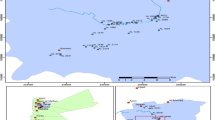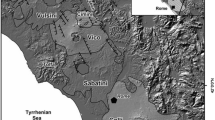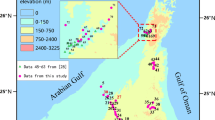Abstract
The seasonal changes in the concentration of uranium in an unconfined groundwater system in Cyprus have been investigated and compared to corresponding changes of boron and salinity, to better understand the chemical behavior of uranium in the respective system. Uranium concentration measurements were performed by alpha spectroscopy after selective pre-concentration, whereas boron concentration analysis and electrical conductivity measurements were carried out by photometry using azomethine-H and an electrical conductivity electrode, respectively. The experimental data show that seasonal variations are mainly related to rainwater infiltration and the specific chemical behavior of a species. Increased levels of uranium and boron in natural water systems are attributed to the increased stability of the uranium(VI)-carbonato complexes and the boric acid, which are in natural waters the predominant chemical species for uranium and boron, respectively. Dilution/dissolution processes govern the seasonal concentration changes of uranium and boron in a groundwater system, however redox-reactions resulting in the reduction of U(VI) to U(IV) affect significantly the concentration of uranium in the respective system, particularly under suboxic conditions.
Similar content being viewed by others
Explore related subjects
Discover the latest articles, news and stories from top researchers in related subjects.Avoid common mistakes on your manuscript.
Introduction
Uranium and its compounds are highly toxic, causing acute kidney failure and death in high concentrations. Because of this high toxicity, an oral reference dose of 0.003 mg kg−1 day−1 is recommended by the US Environmental Protection Agency [1]. Hence, knowledge of the uranium concentration and its seasonal variation in natural waters is important in performing radiological impact assessment of various anthropogenic activities and aims to secure the increased standard of life in modern societies.
Previous studies on alpha-radioactivity levels in Cypriot sea- and groundwater systems have shown that uranium levels in natural waters are basically associated with the origin of the aqueous system and the seasonal variations are mainly related to meteorological conditions (e.g. atmospheric precipitation and evaporation) [2]. In this study we have investigated in parallel the seasonal variation of uranium, boron and electrical conductivity (EC) in an unconfined groundwater to better understand the behavior of uranium in natural water systems.
Boron has been selected for comparison because of its relatively increased concentration in sedimentary groundwater systems in Cyprus [3] and because boron in natural waters exists basically as boric acid, which behaves to a great extent, like water [4]. The electrical conductivity of waters (mS cm−1) is a measure of the salt content (e.g. total dissolved solids) and is basically affected by dilution/dissolution processes, which occur because of rainwater infiltration.
The aim of this study was the evaluation of the concentration changes as a function of time and the estimation of kinetic data for the dilution and dissolution processes. In addition comparison of the uranium and boron or EC data could indicate differences in their seasonal variations, attributed to the different chemical behavior of the species in the groundwater system under study.
Materials and methods
For a calendar year samples were obtained monthly from a groundwater well and sampling of the groundwater (1.5 L) took place by means of a conventional water pump. The well, out of which the groundwater samples were drawn, reached a depth of about 20 m and the ground water system under investigation is hosted by sedimentary rock formations (e.g. maestrichian to middle miocene chalk and marl). The water samples correspond to unconfined groundwater in highly retentive rocks such as chalks interbedded with marls. The relatively increased carbonate and sulfate as well as calcium and magnesium concentrations are characteristic for waters associated with calcareous sediments, originating exclusively from marine sediments [3]. The average temperature of the groundwater was 20 ± 3 °C and during this investigation precipitation occurred in early autumn, followed by a cold, dry winter- and hot, dry summertime, which is usual for semi-arid areas like Cyprus.
Prior to collection for total U analysis, each PTE bottle (1.5 L) was rinsed 2–3 times with the subsequent water sample, to minimize potential elemental contamination from the bottle during storage. The samples were filled in PE bottles and transferred immediately into laboratory for radiochemical analysis. pH and EC measurements were performed using a combined glass- and a conductivity meter, respectively. All analytical experiments were performed in duplicate and the mean values have been used for data evaluation.
For the radiochemical analysis, 200 mL of a water sample were pre-treated by cation-exchange using Chelex 100 and finally the radionuclide was electrodeposited on a stainless steel disc for alpha-spectroscopic analysis [5–7]. Prior cation-exchange the samples were spiked with a known amount of a tracer solution (50 mBq 232U). Specifically, 0.5 g of Chelex-100 resin and 1 g of ammonium acetate were added to 200 mL sample contained in a polypropylene beaker and stirred on a magnetic stirring table. The pH of the solution was adjusted to pH 4.5, with the aid of a pH meter, using 2 M HNO3 solution. After the pH adjustment, the beaker was sealed and stirred for 2 h. The resin was separated from the solution by filtration, with the aid of a Buchner funnel (with sintered glass disc) and washed with 20 mL of distilled water. Following this initial separation, the radionuclides were eluted from the Chelex-100 resin with 15 mL of 2 M HNO3 solution. The acidic solution was evaporated to incipient dryness and the residual was dissolved in 15 mL of 0.15 M (NH4)2SO4 solution. From this solution, uranium was directly electrodeposited on a stainless steel disc (diameter of the active area 10 mm) at a voltage of 15 V and a current of 0.4 A for 2 h [5–7].
Alpha-spectroscopic analysis was performed using a high-resolution alpha-spectrometer (Alpha Analyst Integrated Alpha Spectrometer, Canberra) equipped with semiconductor detectors. Prior to sample measurement, the background was carefully measured under identical conditions and was found to be about 5 counts per day within the energy range of 3–8 MeV. The minimum detectable activity (MDA) reached in the measurements was estimated to be about 1 mBq L−1 at the 95 % confidence limit.
Boron concentration in solution was measured by photometric measurements using azomethine-H as chromophoric agent. The potentiometric pH measurements were carried out by means of a glass electrode (Inolap) attached to a pH meter (WTW). The system was calibrated with buffer solutions (pH 2, 4, 7 and 10, Merck) before and after each measurement. The electrical conductivity (EC) measurements, which correspond to the total dissolved solids, were carried out using an electrical conductivity meter attached to a conductivity electrode.
Results and discussion
Figure 1 shows the relative seasonal variation of the uranium levels in the studied ground water system determined by alpha-spectroscopy after selective extraction of the uranium isotopes by cation-exchange [5–8]. Figure 1 includes also the relative seasonal variation of boron and the EC levels in the respective system. According to Fig. 1 all three parameters reach a minimum in October, which can be, particularly for boron and EC, attributed to dilution processes due to rainwater infiltration in the unconfined groundwater system. However, the uranium concentration starts decreasing some months earlier indicating that other processes like sorption or stepwise precipitation govern the chemical behavior of uranium in the unconfined ground water system. Surprisingly, after October the levels of all three parameters increase steadily and reach their maximum value within 1 month for boron and EC and 3 months for uranium. Since U(VI) is expected to be very stable in solution due to the formation of UO2(CO3) (2n−2)− n complexes [9, 10] and sorption phenomena cannot explain the increase of uranium adsorption. The unusual seasonal changes of the uranium concentration can be explained only by involvement of redox-reactions, affecting its chemical behavior (e.g. solubility) in the studied groundwater system. Specifically, in the hot and dry period (between May and September) no fresh water enters the unconfined ground water, the system is not disturbed from the oxic environment and bacterially catalyzed redox reactions take place resulting most probably in the reduction of U(VI) to U(IV). As consequence uranium concentration decreases steadily in the groundwater, because of the significantly lower solubility of U(IV) [11]. However, when oxic freshwater enters the system, because of rainwater infiltration, U(IV) is re-oxidized to U(VI) resulting again in increased uranium concentration in solution.
Figure 2 shows graphically the absolute changes of the values for uranium and boron concentration and EC as a function of time (days) and the corresponding data are summarized in Table 1. The time-axis of Fig. 2 corresponds to the time-axis of Fig. 1, however in Fig. 2 the time is given in continuous data (number of days passed since the beginning of the measurements) rather than in nominal terms (months) as is the case in Fig. 1. According to the data in Fig. 1, the minimum (398 mBq L−1) is reached in October and the maximum uranium concentration (730 mBq L−1) in January and remains almost stable until May. Generally, the minimum and maximum levels as a function of time are similar with the corresponding maximum and minimum levels for boron and EC. However, in contrast to boron and EC levels, which behave almost identically, the curve corresponding to the relative seasonal variation of uranium shows a hysteresis, which could be attributed to the different chemical behavior of uranium in comparison to boron and EC (e.g. the concentration of dissolved solid).
Boron exists in the studied systems predominantly as boric acid, is a relatively small and neutral molecule and behaves more or less like water [4]. Hence its seasonal variation can be solely attributed to dilution processes by rainwater infiltration into the unconfined groundwater system particularly in the time period between September and October and following dissolution of boron from the geological matrix in the groundwater, which results in reaching again the initial (maximum) concentration almost within 30 days. Similar to boric acid behaves EC, which corresponds to the concentration of the total dissolved solids, supporting the previous assumption of dilution and dissolution processes. The maximum boron concentration amounts 1.28 mg L−1 and the value of EC is equal to 0.739 mS cm–1 (Table 2).
On the contrary, the uranium levels don’t behave similar to boric acid levels indicating that additional processes control the uranium concentration in an unconfined groundwater system. As already mentioned the only reasonable process that could account for the different behavior of uranium is the reduction of the hexavalent uranium to tetravalent uranium, which could be also catalyzed by bacteria present in the unconfined groundwater system. The corresponding redox reaction and Nernst equation are given by Eqs. 1 and 2, respectively:
However, because under groundwater conditions U(VI) exists predominantly as UO2(CO3) 4−3 the redox reaction can be formulated as follows:
Carbonate complexation stabilizes U(VI) in the form of UO2(CO3) (2n−2)− n complexes in solution and hence the standard redox potential required for its reduction decreases significantly to negative values (Fig. 3). Nevertheless, in the presence of reducing species (e.g. natural organic matter) and microorganisms U(VI) can be reduced to U(IV) [14]. This reduction can occur whether in the reducing environment of microorganisms [15] or through direct enzymatic reduction [16].
To estimate the reaction rate constants the experimental data have been plotted in a log([U]t − [U]min)–time diagram, which is shown in Fig. 4. [U]t is the uranium concentration in solution at a given time (in days) and [U]min is the minimum uranium concentration determined in the groundwater under study. Similar evaluation has been performed also for the boron and EC data and the corresponding kinetic data are summarized in Table 2. According to Fig. 4, the decrease in uranium concentration starts not only earlier but occurs also almost 40 times faster than the decrease of the boron and EC levels. Because the early decrease of the uranium concentration is ascribed to U(VI) reduction to U(IV) and the following precipitation of U(OH)4/UO2, the reaction rate constant, which has been evaluated from the experimental data, corresponds to the geochemical reduction rate of uranium in the groundwater under study. In addition, the fact that uranium starts re-dissolving after the freshwater infiltration clearly indicates that the dissolution is supported by oxidation of U(IV) induced by (oxic) rainwater infiltration into the unconfined groundwater system. In this context, it is noteworthy to point out that the dilution and dissolution rate constants determined for boron and EC are almost similar, supporting the assumption that the chemical behavior of boric acid and total dissolved solids is basically governed by dilution and dissolution processes.
Conclusions
-
Seasonal variations of the uranium levels that correspond to an unconfined groundwater hosted by sedimentary rock formation are governed by precipitation/dilution and dissolution phenomena.
-
The seasonal variations of uranium, boron and EC in an unconfined groundwater system differ significantly, because of the different geochemical behavior of the uranium species in the respective system. The latter as redox sensitive species is reduced during the dry and hot summer period from U(VI) to U(IV) resulting in the precipitation of U(OH)4/UO2 and dissolution because of re-oxidation of U(IV) to U(VI) when (oxic) rainwater enters the groundwater system.
References
US EPA (1994) Comparison of health risks arising from the radiological and chemical toxicity of uranium, appendix f of radiation site cleanup regulations: technical support document for the development of radionuclide cleanup levels for soil. Review Draft, EPA 402-R-96-011 A. DC: EPA (Environmental Protection Agency)
Tsiaili A, Kiliari T, Pashalidis I (2011) Radiat Meas 46:145
Georghiou G, Pashalidis I (2007) Desalination 215:104
Pashalidis I (2010) In: Chung MP (ed) Handbook on borates: chemistry, production and applications. Nova Publishers, New York
Antoniou S, Tsiaili A, Pashalidis I (2008) Radiat Meas 43:1294
Kiliari T, Pashalidis I (2010) J Radioanal Nucl Chem 284:547
Kiliari T, Pashalidis I (2012) Radiochim Acta 100:439
Efstathiou M, Kiliari T, Pashalidis I (2011) Radiat Meas 46:626
Konstantinou M, Pashalidis I (2004) Mediterr Marine Sci 5:55
Pashalidis I, Czerwinski KR, Fanghaenel Th, Kim JI (1997) Radiochim Acta 76:55
Choppin GR (2007) J Radioanal Nucl Chem 273:695
Langmuir D (1997) Aqueous environmental geochemistry. Prentice-Hall, Upper Saddle River
Papanicolaou F, Antoniou S, Pashalidis I (2009) J Environ Radioact 101:601
Ginder-Vogel M, Fendorf S (2008) In: Barnett MO, Douglas BK (eds) Developments in earth and environmental sciences, vol 7. Elsevier, Amsterdam
Wilkins MJ, Livens FR, Vaughan DJ, Lloyd JR (2006) Biogeochem 78:125
Lovley DR, Phillips EJP (1992) Environ Sci Technol 26:2228
Author information
Authors and Affiliations
Corresponding author
Rights and permissions
About this article
Cite this article
Efstathiou, M., Aristarchou, T., Kiliari, T. et al. Seasonal variation, chemical behavior and kinetics of uranium in an unconfined groundwater system. J Radioanal Nucl Chem 299, 171–175 (2014). https://doi.org/10.1007/s10967-013-2787-1
Received:
Published:
Issue Date:
DOI: https://doi.org/10.1007/s10967-013-2787-1








